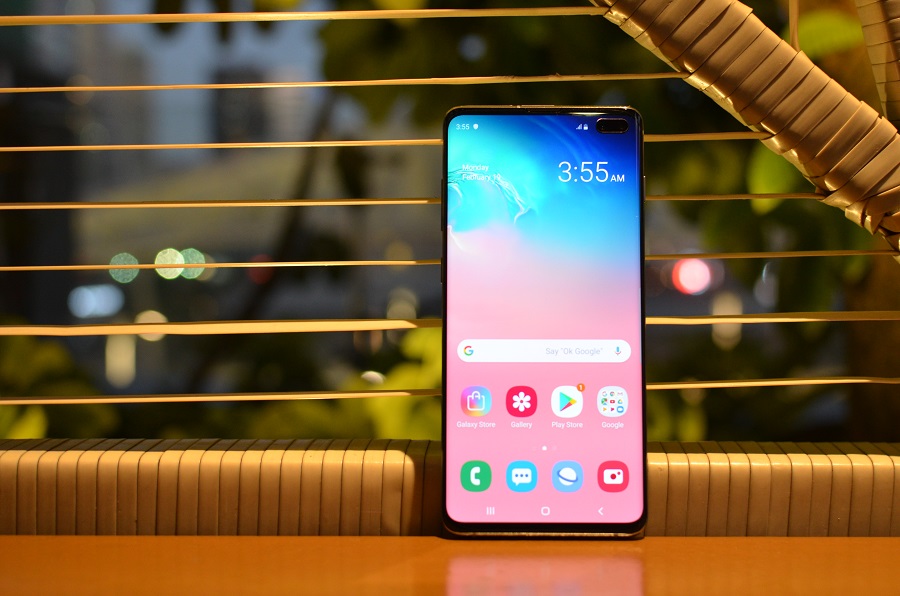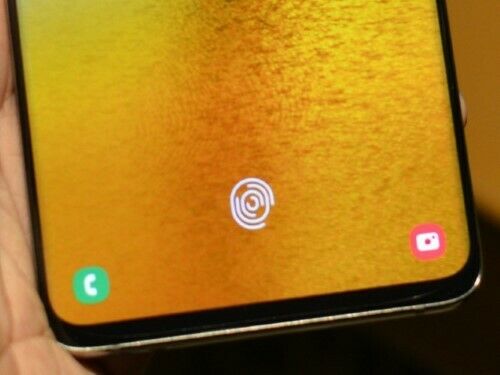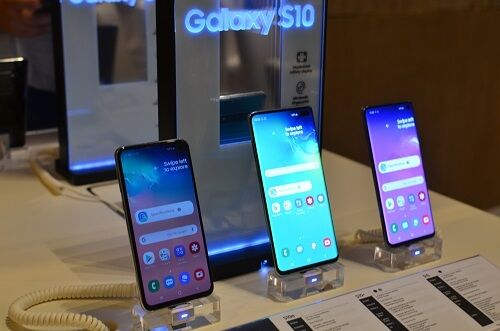
Now that Samsung has finally taken off the wraps off its latest Samsung Galaxy S10+, S10, and S10e flagships, one question is in the minds of anyone currently in the market for a new smartphone: how does it compare to other current flagship phones?
| Samsung Galaxy S10+ | Apple iPhone XS Max | Samsung Galaxy Note9 | Huawei Mate 20 Pro | |
|---|---|---|---|---|
| OS: | Android 9.0 Pie | iOS 12 | Android 8.1 Oreo (upgradable to Android 9.0 Pie) | Android 9.0 Pie EMUI 9 |
| Processor: | Samsung Exynos 9820 (8nm) (2x2.7 GHz Mongoose M4 + 2x2.3 GHz Cortex-A75 + 4x1.9 GHz Cortex-A55) Mali-G76 MP12 GPU | Apple A12 Bionic (7nm) 6 cores (2 x 2.5 GHz Vortex + 4 x 1.6 GHz Tempest) Apple GPU (4-core) | Samsung Exynos 9810 (10nm) (4x2.7 GHz Mongoose M3 + 4x1.8 GHz Cortex-A55) Mali-G72 MP18 GPU | HiSilicon Kirin 980 (7nm) (2x2.6 GHz Cortex-A76 + 2x1.92 GHz Cortex-A76 + 4x1.8GHz Cortex-A55) Mali-G76 MP10 GPU |
| Display: | 6.4" (19:9) 3040x1440 QHD+ 522 ppi Infinity "O" curved display with Gorilla Glass 6 | 6.5" 1242x2688 19.5:9 Super AMOLED scratch-resistant glass HDR10 3D Touch | 6.4" 1440x2960 18.5:9 Super AMOLED Gorilla Glass 5 HDR10 | 6.39" 1440x3120 19.5:9 AMOLED Gorilla Glass 5 DCI-P3 HDR10 |
| Wireless Connections: | LTE, Bluetooth 5.0, Wi-Fi 802.11 a/b/g/n/ac, NFC, A-GPS, GLONASS | LTE, Bluetooth 5.0, Wi-Fi 802.11 a/b/g/n/ac dual-band, NFC, A-GPS, GLONASS, GALILEO, QZSS | LTE, Bluetooth 5.0, Wi-Fi 802.11 a/b/g/n/ac dual-band | LTE, Bluetooth 5.0, Wi-Fi 802.11 a/b/g/n/ac dual-band, NFC, A-GPS, GLONASS, BDS, GALILEO, QZSS |
| Memory & Storage: | 8GB + 128GB 12GB + 1TB | 4GB + 64GB/256GB/512GB non-expandable | 6GB + 128GB 8GB + 512GB expandable w/ microSD card up to 512GB (uses 2nd SIM slot) | 6GB + 128GB 8GB + 256GB expandable w/ Nano Memory up to 256GB (uses 2nd SIM slot) |
| Security: | Ultrasonic under-display fingerprint scanner | Face ID | Iris scanner Rear-mounted fingerprint scanner | Face ID Under-display fingerprint sensor |
| Connectors: | USB Type-C OTG Support 3.5mm audio jack | Lightning port | USB Type-C OTG Support 3.5mm audio jack | USB Type-C OTG Support |
| Cameras: | Rear: 12 MP OIS f/1.5-f/2.4 77-degree, dual-aperture, dual pixel AF + 12 MP f/2.4 45-degree telephoto, OIS, AF + 16 MP f/2.2 fixed-focus, 12mm 123-degree ultra-wide Front: 10MP (f/1.9) dual-pixel AF UHD + 8MP (f/2.2) | Rear: 12 MP OIS, f/1.8 + 12 MP OIS, f/2.4 telephoto (2x optical zoom) Front: 7 MP, f/2.2 | Rear: 12 MP OIS, dual pixel AF, dual aperture (f/1.5 - f/2.4) + 12 MP OIS, AD, f/2.4 telephoto Front: 8 MP, f/1.7 AF | Rear: 40 MP, f/1.8 laser AF + 20 MP, f/2.2, 16mm ultrawide, laser AF + 8 MP, f/2.4, telephoto 5x optical zoom, OIS, laser AF Front: 24 MP, f/2.0 |
| SIM Card Slots: | 2x Nano SIM Cards | Single Nano SIM | Single Nano SIM or Hybrid Dual Nano SIM | Single Nano SIM or Hybrid Dual Nano SIM |
| Battery & Charging: | 4,100 mAh (non-removable) 15W wireless charging 9W reverse wireless charging | 3,174 mAh (non-removable) 15W fast charging Qi wireless charging | 4,000 mAh (non-removable) 18W fast charging Qi wireless charging | 4,200 mAh (non-removable) 40W fast charging 15W fast wireless charging Reverse wireless charging |
| Water & Dust resistance | IP68 dust & water resistance up to 1.5 meters for 30 mins. | IP68 dust & water resistance up to 2 meters for 30 mins. | IP68 dust & water resistance up to 1.5 meters for 30 mins. | IP68 dust & water resistance up to 2 meters for 30 mins. |
| SRP: | P55,990 (8GB+128GB) | P74,990 (64GB) P84,490 (256GB) P97,490 (512GB) | P55,900 (128GB+6GB) P75,900 (512GB+8GB) | P49,990 (6GB+128GB) |
Above is a table of the bleeding-edge smartphones today. From the Chinese sensation that has certainly swept everyone off their feet last year is the Huawei Mate 20 Pro. From Samsung’s own camp, the no-compromises king of productivity, the Galaxy Note9. Last, but not least, from iOS camp is Apple’s ever-popular iPhone XS Max. We’ll be comparing all three to the Galaxy S10+. This is the best of the best comparison after all.
DISPLAY

Straight away the Samsung Galaxy S10+ trades blows with its fellow Android phones. The Galaxy Note 9 may have a notch-less design, but loses out on screen-to-body ratio and pixel density. The Huawei Mate 20 Pro may also have a curved edge AMOLED display, but the notch is more substantial than the punch-hole camera on the Galaxy S10+. Meanwhile, the iPhone XS Max still carries Apple’s signature 3D touch technology. Other than that, however, it feels dated compared to the others here.
STORAGE
The Samsung Galaxy S10+ is the clear victor here as its starting model comes equipped with 128GB of storage, firmly planting it on level ground with the Galaxy Note9 and Mate 20 Pro base models. Both of the latter have expandable storage, but the Mate 20 Pro uses the very rare Nano Memory Card. The iPhone XS Max has more available storage options. Having no expandable storage means you can’t upgrade in the future, however.
The Galaxy S10+ pulls ahead by a significant margin with its 1TB variant. It bests even last year’s Galaxy Note9, which maxed out with an already impressive 512GB of internal storage.
CAMERA

With a total of 5 cameras, 3 at the back and two at the front, the Galaxy S10+ has the most comprehensive set of cameras in this shoot-out. Sheer megapixel count won’t tell the whole story, but it is interesting to note that the Galaxy S10+, iPhone XS Max, and Galaxy Note9 all have 12MP main cameras at the back.
Apple and Samsung have generally traded blows in terms of camera performance in recent years. Having the same dual-aperture + telephoto lens setup form the Galaxy Note9, the Galaxy S10+ pulls off a clear win simply because of the addition of an ultra-wide sensor. This makes it more versatile than both the Galaxy Note9 and the iPhone XS Max.
Where things get a bit tricky (and more interesting) is with regards to the Mate 20 Pro. Due to the way the Mate 20 Pro’s 40 MP sensor is used, which combines four adjacent pixels to capture more light, it will be interesting to see how well the dual-aperture 12 MP sensor on the Galaxy S10+ fares against it. For the telephoto lens, the Mate 20 Pro goes further at 5x optical zoom while the Galaxy S10+ sits at 2x optical zoom. The Galaxy S10+ strikes back by having a wider 12mm wide-angle lens compared to the Mate 20 Pro’s 16mm.

Something unique to the Galaxy S10+ is the dual lens setup for the front camera. It houses a 10 MP 4K-capable main shooter and an 8MP depth sensor. This should significantly help with bokeh effects or Live Focus as Samsung would call it. With the other phones here having a single front camera, bokeh effects are mostly software software solutions.
SECURITY

The Galaxy S10+ debuts the new ultrasonic on-display fingerprint scanner. This promises to be more secure than the optical fingerprint scanner used in the Mate 20 Pro and even the capacitive fingerprint scanner in the Galaxy Note9. It would be fair to say that Samsung is very confident in this new tech because it hasn’t implemented Face ID, like the Mate 20 Pro, iPhone XS Max, and indeed almost all other flagships at this point.
BATTERY AND CHARGING
The Samsung Galaxy S10+ is second only to the Mate 20 Pro in terms of battery capacity, but beats out the Galaxy Note9 by 100 mAh. Combine that with the more efficient Exynos 9820 SoC, it should last substantially longer than the Galaxy Note9.
Instead of taking the Mate 20 Pro’s challenge of a 40W fast charging solution, Samsung has opted to increase wireless charging speed instead. It now goes up to an impressive 15W. To put that into perspective, that’s about the same as the iPhone XS Max’s wired fast charging speed. That said, the Galaxy S10+ wired fast charging speed also tops out at 15W.
Reverse wireless charging is also supported at 9W, beating out the Mate 20 Pro’s which has been found to be extremely slow.
SOC PERFORMANCE
While we have to wait until we can properly benchmark the Galaxy S10+, for now we can go by Samsung’s own performance figures. The Exynos 9820 octacore is an evolution of the Exynos 9810 found in the Galaxy Note9 and Galaxy S9. Samsung quotes CPU and GPU performance increases of up to 33% and 37% respectively. This while simultaneously lowering power consumption by as much as 15%, which is no doubt thanks to the more efficient 8nm process.

It’s almost a forgone conclusion that the Galaxy S10+ won’t be able to match the iPhone XS Max in sheer performance where Apple has always had the advantage. The more interesting battle to see once benchmarks hit is against, again, the Mate 20 Pro. There’s a similar 4-core Cortex-A55 cluster between the two, with the Galaxy S10+’s being clocked slightly higher. But its a complete toss-up once we start comparing the bigger 2+2 core clusters since each phones use different core designs. The Galaxy S10+ should have faster GPU performance though since it has a Mali-G76MP12 while the Mate 20 Pro has a Mali-G76MP10.
CONCLUSION
The new Samsung Galaxy S10+, S10, and S10e have made a big splash into this year’s new round of amazing smartphones. Arguably making the biggest splash among the three, the Galaxy S10+ currently represents the best of what Samsung has to offer and is, therefore, among the best Android phones to date.

In all aspects, the Galaxy S10+ has something more to offer than its competitors from last year. If there were some among us who felt that going from the S8+ to the S9+ was a very incremental upgrade, they won’t be saying that this time around. From the looks to the tech inside, everything’s been improved.
Other smartphone makers beware, a new benchmark has been set.





